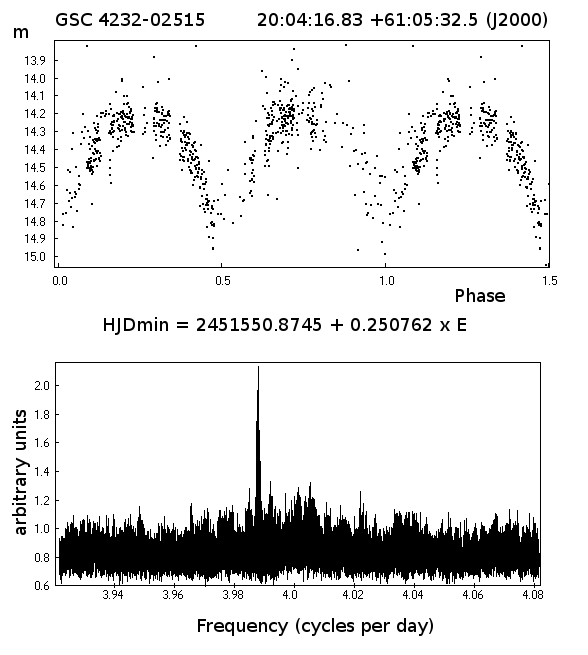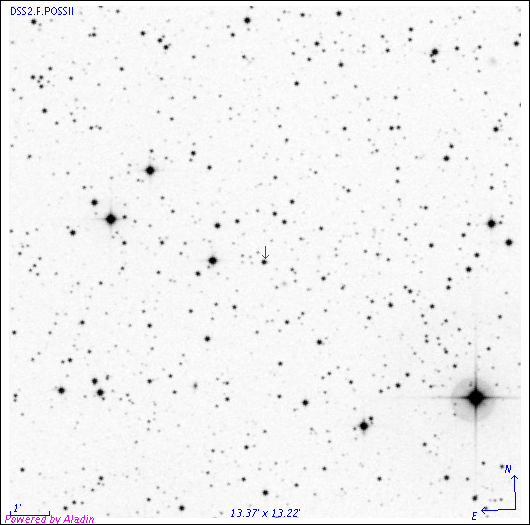"Peremennye Zvezdy",
Prilozhenie,
vol. 7, N 26 (2007)
Prilozhenie,
vol. 7, N 26 (2007)
GSC 4232-02515 - a New Eclipsing Binary Star
K. V. Sokolovsky#1,2, D. O. Chekhovich#3, S. A. Korotkiy#4
#1 Sternberg Astronomical Institute, Moscow State University;
#2 Astro Space Center of the Lebedev Physical Institute, Russian Academy of Sciences;
#3 Visiting observer, Ka-Dar Public Observatory;
#4 Ka-Dar Public Observatory
#2 Astro Space Center of the Lebedev Physical Institute, Russian Academy of Sciences;
#3 Visiting observer, Ka-Dar Public Observatory;
#4 Ka-Dar Public Observatory
Received: 4.09.2007; accepted: 24.10.2007
(E-mail for contact: idkfa@sai.msu.ru)
| ||||||||||||||||||||||
Remarks: |
| During observations of a secondary eclipse of GSC 04232-02830 (Goranskij et
al., 2005) on August 8, 2007, we identified GSC 4232-02515 as a W UMa eclipsing
binary.
Our observations were carried out at the Ka-Dar Public Observatory, Moscow Region (http://www.ka-dar.ru), with the Vixen (D=102mm, F=795mm) refractor equipped with a SBIG ST2000XM unfiltered CCD camera. The all-night series of images was analyzed with VAST software (Sokolovsky & Lebedev, 2005) to check if the eclipse of our target star was detected. Our large field of view resulted in detection of two more variable objects in the same field, GSC 4232-02515 (discussed here) and GSC 4232-02059 (discussed in a separate paper). VAST software was used for aperture photometry. No specific comparison star was selected, instead, all stars were matched with stars on the reference image (typically, a few hundred stars), used as comparison stars simultaneously. This method produces a light curve with an arbitrary zero point. The spectral response curve of KAI-2020M CCD chip used in our ST-2000XM camera is completely different from that of Thomson TH7899M chips used in ROTSE-I/NSVS AP10 cameras. KAI-2020M reaches its maximum quantum efficiency in the 410 - 550 nm range, while TH7899M, at 650 - 800 nm. Fortunately, we do not expect any significant color change during eclipses, at least within the precision of NSVS photometry. Thus, we have simply shifted the zero point of the light curve to match its magnitude at maximum light to the magnitude at maximum of the NSVS light curve. After combining our photometry with NSVS data (Wozniak et al., 2004; see also http://skydot.lanl.gov/nsvs/nsvs.php), the light elements of GSC 4232-02515 were determined: HJDmin = 2451550.8745 + 0.250762xE. The secondary minimum has approximately the same depth as the primary minimum. GSC 4232-02515 is a short-period EW star, so a simplified Period-Luminosity relation for W UMa eclipsing binaries can be applied (Rucinski, 2007; Rucinski, 2004). We have no Johnson V photometry for the system, so the empirical magnitude system conversion formula by John Greaves (http://www.aerith.net/astro/color_conversion.html) was used. Information on the galactic extinction in the direction of the system was extracted from NED. Taking into account uncertainties coming from the period-luminosity relation itself (0.2m), the NSVS-to-V magnitude conversion formula (0.2m), and the uncertainty in the interstellar extinction (can be any from 0 to 0.4m), the distance to GSC 4232-02515 is estimated to be 380 (-60/+180) pc. Acknowledgments: This research has made use of the NASA/IPAC Extragalactic Database (NED) which is operated by the Jet Propulsion Laboratory, California Institute of Technology, under contract with the National Aeronautics and Space Administration. This research has made use of Aladin Sky Atlas, operated at CDS, Strasbourg, France. The authors are grateful to V.P. Goranskij for providing software used for our light-curve analysis and to all observers who visited the Ka-Dar Observatory on August 8, 2007 for their assistance during the observations. K.V.S. is grateful to the Russian Foundation for Basic Research for financial support through grant No. 05-02-16688. |
| References: |
| Goranskij, V. P., Shugarov, S. Yu., Kroll, P., Golovin, A., 2005, IBVS, No. 5618
Rucinski, S. M., 2007, accepted by MNRAS, arXiv:0708.3020v1 Rucinski, S. M., 2004, New Astronomy Reviews, 48, 703 Sokolovsky, K., Lebedev, A., 2005, in 12th Young Scientists' Conference on Astronomy and Space Physics, Kyiv, Ukraine, April 19-23, 2005, eds.: Simon, A., Golovin, A., p.79 (VAST: http://saistud.sai.msu.ru/vast) Wozniak, P.R., Vestrand, W.T., Akerlof, C.W., et al., 2004, AJ., 127, 2436 |
Light Curve
Light curve of GSC 4232-02515 in NSVS magnitude scale. Finding Chart 
Data Source |